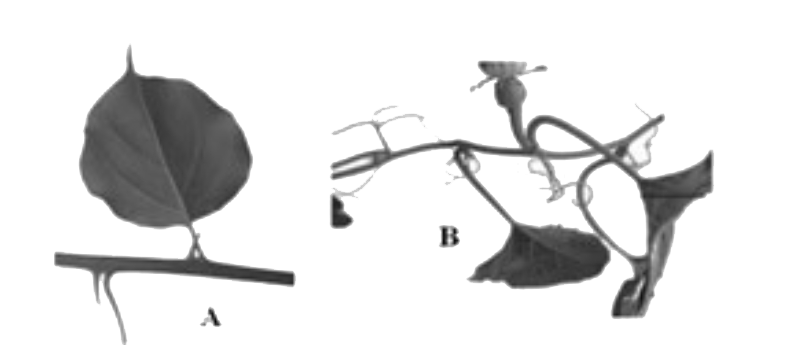Describe modifications of stem with suitable examples.
Step-by-Step Solution:
1. Introduction to Stem Modifications:
- Stems can undergo various modifications to perform different functions. These modifications can be classified based on their primary functions such as storage, support, protection, photosynthesis, and propagation.
2. Storage Stems:
- Rhizomes:
- An underground stem that stores nutrients.
- Example: Ginger and banana.
- Corms:
- Another type of underground stem that stores food and is swollen.
- Example: Colocasia (also known as taro).
- Tubers:
- Swollen underground stems that serve as storage organs.
- Example: Potato, which contains starch and has buds for vegetative propagation.
3. Supportive Stems:
- Tendrils:
- Modified stems that are coiled and help support climbing plants.
- Example: Found in cucumbers and melons (family Cucurbitaceae).
4. Protective Stems:
- Thorns:
- Sharp, pointed structures that deter herbivores and protect the plant.
- Example: Citrus plants (like lemon and orange) and Bougainvillea.
5. Photosynthetic Stems:
- Some stems can perform photosynthesis due to their green color.
- Example: Opuntia (a type of cactus) has stems that are modified to be green and carry out photosynthesis.
6. Other Modifications:
- Stolons or Runners:
- Horizontal stems that grow along the ground and help in vegetative propagation.
- Example: Common in grasses and aquatic plants like *Eichhornia crassipes* (water hyacinth), which spreads rapidly and can be harmful to water bodies.
Summary:
In summary, stem modifications serve various essential functions such as storage (rhizomes, corms, tubers), support (tendrils), protection (thorns), photosynthesis (green stems), and propagation (stolons/runners). Each type of modification is adapted to meet the specific needs of the plant.
---
- Stems can undergo various modifications to perform different functions. These modifications can be classified based on their primary functions such as storage, support, protection, photosynthesis, and propagation.
- Rhizomes:
- An underground stem that stores nutrients.
- Example: Ginger and banana.
- Corms:
- Another type of underground stem that stores food and is swollen.
- Example: Colocasia (also known as taro).
- Tubers:
- Swollen underground stems that serve as storage organs.
- Example: Potato, which contains starch and has buds for vegetative propagation.
- Tendrils:
- Modified stems that are coiled and help support climbing plants.
- Example: Found in cucumbers and melons (family Cucurbitaceae).
- Thorns:
- Sharp, pointed structures that deter herbivores and protect the plant.
- Example: Citrus plants (like lemon and orange) and Bougainvillea.
- Some stems can perform photosynthesis due to their green color.
- Example: Opuntia (a type of cactus) has stems that are modified to be green and carry out photosynthesis.
- Stolons or Runners:
- Horizontal stems that grow along the ground and help in vegetative propagation.
- Example: Common in grasses and aquatic plants like *Eichhornia crassipes* (water hyacinth), which spreads rapidly and can be harmful to water bodies.
In summary, stem modifications serve various essential functions such as storage (rhizomes, corms, tubers), support (tendrils), protection (thorns), photosynthesis (green stems), and propagation (stolons/runners). Each type of modification is adapted to meet the specific needs of the plant.
Topper's Solved these Questions
- MORPHOLOGY OF FLOWERING PLANTS BOOK - ICSECHAPTER - MORPHOLOGY OF FLOWERING PLANTS EXERCISE - Ncert Exercises (Differentiate Between )
21 Videos
- MORPHOLOGY OF FLOWERING PLANTS BOOK - ICSECHAPTER - MORPHOLOGY OF FLOWERING PLANTS EXERCISE - REVIEW QUESTIONS (I. MULTIPLE CHOICE QUESTIONS)
24 Videos
- MORPHOLOGY OF FLOWERING PLANTS BOOK - ICSECHAPTER - MORPHOLOGY OF FLOWERING PLANTS EXERCISE - Test Your Progress (HOTS)
4 Videos
- MORPHOLOGY AND ANATOMY OF DIFFERENT SYSTEM OF COCKROACH BOOK - ICSECHAPTER - MORPHOLOGY AND ANATOMY OF DIFFERENT SYSTEM OF COCKROACH EXERCISE - Long Answer type Questions
6 Videos
- NEURAL CONTROL AND CO-ORDINATION BOOK - ICSECHAPTER - NEURAL CONTROL AND CO-ORDINATION EXERCISE - NCERT EXERCISES WITH ANSWER (DIFFERENTIATE BETWEEN)
11 Videos
Similar Questions
What is a joint? Describe various types of joints with suitable examples.
View SolutionIn the given diagrams, A ( spine ) and B ( tendril ) are structured which are modifications of the stem. Then , probable examples of plants in which A and B can be observed , respectively , will be. :

View SolutionDescribe various modifications of the leaf.
View SolutionDefine fragmentation with suitable examples.
View SolutionExplain the terms with suitable examples:
Aerosol
View SolutionExplain the terms with suitable examples:
Hydrosol
View SolutionExplain the terms with suitable examples:
Alcosol
View SolutionDescribe vestigial organs with suitable examples.
View SolutionDiscuss the process of roasting with suitable example.
View SolutionDiscuss the process of roasting with suitable example.
View Solution
